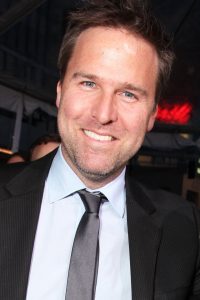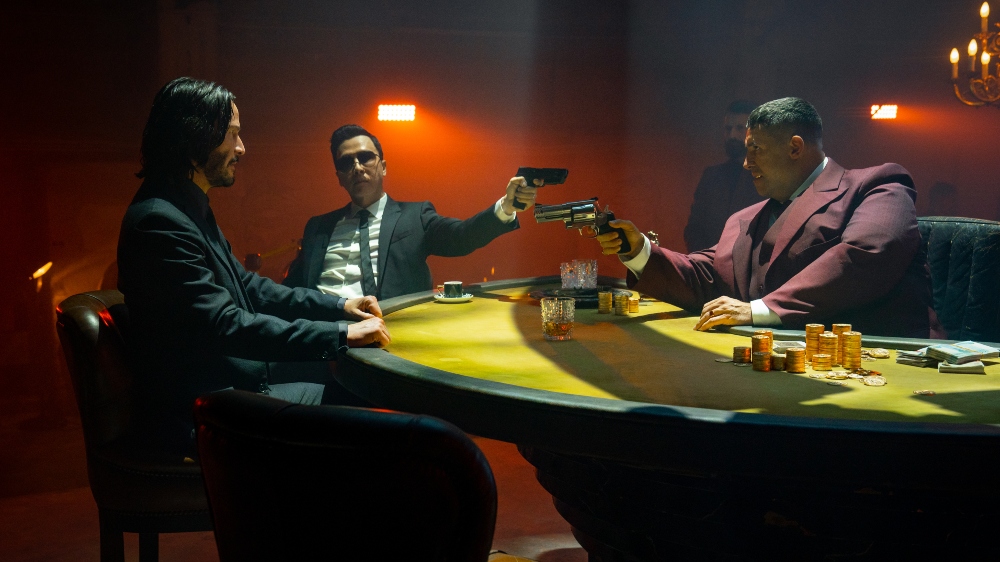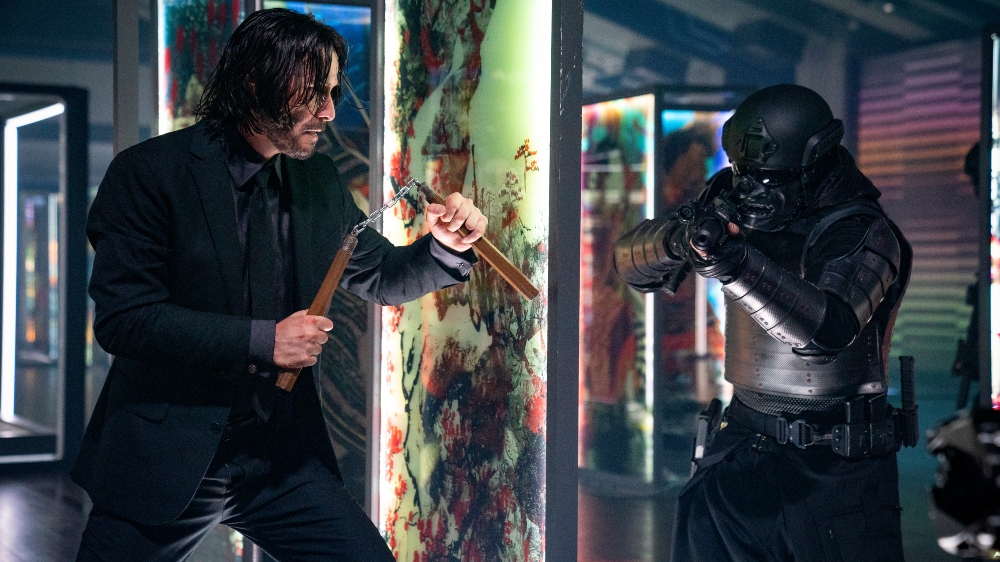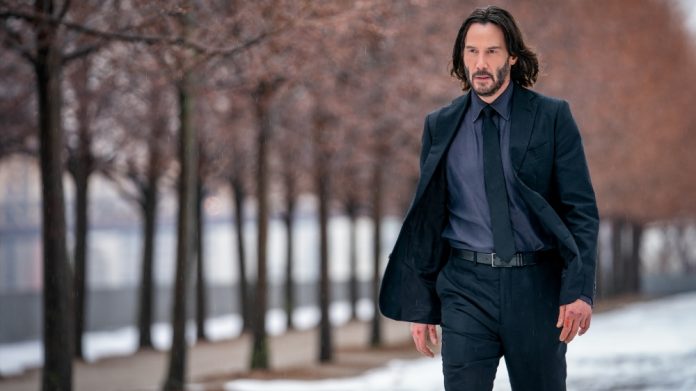Producer Basil Iwanyk has shepherded several franchises to the screen, including Sicario, Clash of the Titans, and The Expendables. However, his biggest and most enduring global brand has to be the John Wick films, which have spawned four features plus the recent Mel Gibson-led Peacock series The Continental and the forthcoming spin-off film Ballerina, starring Ana de Armas. The most recent entry, John Wick: Chapter 4, was such a rousing success, both critically and commercially, that Iwanyk is now doing another round of press, possibly to court awards season voters about the merits of the film.
Said merits are plentiful, as the fourth John Wick entry is chockablock with stunning production design, brilliant sound, exquisite photography (especially in real-life global locales where the film was shot), and even a remarkable turn from Keanu Reeves that seemingly closes out the title character’s story.
Above the Line chatted with Iwanyk about the humble beginnings of the franchise, how it has evolved over four films and counting, as well as how the John Wick movies defy traditional storytelling benchmarks.

Above the Line: I remember talking to Keanu for the first movie years ago, and he was just kind of crossing his fingers that Wick could become a viable franchise for him. Was the level of success this series has had even a twinkle in your eye back in 2014, or did you always have faith it would connect the way it ultimately has?
Basil Iwanyk: No, no, no. Honestly, I just wanted to make an independent movie that was cool. We made the movie without a studio, with nobody. Purely independent. I always said the creative team could fit around a small conference room table. It was Chad [Stahelski], Dave [Leitch], Derek Kolstad, [Producer] Erica [Lee], myself, and Keanu, of course. We deliver the same movie you’ve seen in the theaters, and we show it to every studio in town – every studio passed. I’m telling you, there wasn’t even a speck of “Could this start a franchise?” In fact, right after we did John Wick, we did Sicario. and I remember thinking to myself, “Okay, John was gonna come out straight to video, but at least I have Sicario. It’s great. John Wick will be like a little blip.” None of us had any idea. The only time we start getting a little excited was when we saw Lionsgate’s trailer and we’re like, “Wow, that’s cool.” Then we went to Fantastic Fest and people love the movie. We’re like, “Okay, at least we’re not going to embarrass ourselves. We’ll be okay.” But there was zero chance that any of us thought we’d be where we are today. Zero. I don’t care what anyone says.
ATL: There are very few number 4’s of anything that land well, but this film was very well received, both critically and at the box office. What has been the biggest highlight for you in terms of the way the world embraced this fourth movie?
Iwanyk: I think people are recognizing that the craft of filmmaking is exquisite and beautiful. I don’t mean we’re the greatest movie ever made, but the filmmaking, the texture, the sound design, the lighting, the choreography, the costumes… the John Wick franchise is starting to be appreciated for its craft, not just the entertainment part of it. That, to me, has been really gratifying. Then on the second level, you know, we’ve been coming at the audience every two or two-and-a-half years, and there’s no sign that they’re sick of it.

ATL: I was re-watching the movie and the point where the Marquis and John meet to decide the terms of their duel would have, in most other movies, been the prelude to the climax, but this movie is unique and decides, “No, we want another hour of action.” Why was it important to you and Chad and Keanu to give audiences basically a whole extra act for this installment?
Iwanyk: We never talk about the Wick movies with the traditional three-act structure. Chad likes to joke that he has no idea how to pull off a second act. If you look at some of our movies, it’s like the first act is big and the third act is huge, and the second act is just in the middle there. In all the John Wick director’s cuts – which have been really long as you can imagine – 80% of the cuts have been in that middle/second act. We don’t have any structural signposts that we try to get to. It truly is, you know, three hours and 50 minutes, and we go, “Let’s keep all the cool shit.” When the dust clears, we have some structure, which makes no sense at times in terms of the traditional or what we’re supposed to be doing. But we’re like, “F***it.” There’s a part of me that thinks the audience appreciates that loopiness. I’m not talking about the length, I’m talking about that it’s just not traditional. Movies one through four take place over like six months. We don’t slow down to explain things. We break a lot of rules of traditional storytelling. I think people were fine with it.
ATL: You’ve been on several big franchises, so you know better than anyone that as the budget, scope and above the line costs go up, the margin for profit often goes down. How were you able to keep the financials of the John Wick franchise sustainable over four films?
Iwanyk: Good question. I think that it terms of other franchises, by the time you get to three and four, our movies are shockingly cheaper than traditional movies that get to chapters three and four. When it’s all said and done, this came from an independent movie that was financed ourselves. Believe it or not, there’s still a feeling amongst all of us that we’re making an independent movie, that we’re scrappy, that we are getting away with it. That we are not part of the cool kids table, that we have to work a little harder than everybody else because we’re so odd, in terms of the craziness of it. We feel like underdogs. I know that sounds insane, but we just do. I don’t want to say it’s humility, but we’re also amused by how many people love this thing that we’re going, “Oh, shit, are they going to figure this out one day?” So we’ve got to give them something awesome.
Sometimes, with gigantic budgets, you start softening the edges, you start being a little complacent. You start not working that extra two hours, you lose an edge a bit. I give that to Chad. Ben Affleck is a little bit like this, too, but in Chad’s world if it’s not hard, it’s not good. He and Keanu push themselves really far, and how that manifests in budget is it doesn’t matter how much we’re given, we’re going to push past what we need to push. And we are Rated R. We’re aware we’re not gonna open up to $150 million dollars. We are all self-aware of where we fit in the calculus of commercial. Frankly, we want to make sure that we could still keep on making more and people still make money off it.

ATL: Yeah, a $250 million dollar John Wick movie is not going to fly.
Iwanyk: No, not at all.
ATL: One of the things you guys do so well is acquiring production value through shooting in so many incredible real locations all over the world. Which of those locations caused the most headaches for you?
Iwanyk: I’m gonna brag for a bit: On John Wick 1, everybody said to me, “Shoot it in Cape Town, you will have 15 more days and more money,” and I insisted on shooting in New York City. The philosophy behind it – because it’s very hard to shoot in New York City, very hard – if you and I are being filmed talking in front of some f**king building in Toronto or Cape Town, you feel like you’re watching a small movie. But if you and I are filmed and the Brooklyn Bridge is in the background, or at night you see a New York skyline, you go, “Oh, it’s a big movie.” That was free.
To me, it sounds counterintuitive, but I thought, “We don’t have a lot of money, so let’s show New York, let’s make sure we’re outside. Let’s make sure we’re grand. We’re punching above our weight, it feels like a bigger movie than it is. That is the kind of philosophy we’ve applied all through the four films, which is, “let’s go outside, and when we shoot it let’s have something in the background.” People go, “Wow.” All that came from that first John Wick movie, because I remember going, “You’re making an independent movie with first time directors in New York City? Action? Undoable.” Obviously, we pulled it off, but I also think it started the grandness of these movies. And listen, Rome was tough. They’re there all tough. Berlin and Paris are amazing. Morocco was amazing, but we had some crazy weird weather… believe it or not it rained all the time. Rome’s tough because you show up in Rome and you want to shoot in all these places, and you realize you have a choice of like eight places because everything’s owned by the church. That was tough. My favorite was New York. I mean, New York is hard, but you’re in New York. I live now in New York. We shot the shit out of New York. To me, shooting cool locations is part of the John Wick creative ethic.
John Wick: Chapter 4 is now available on Digital, 4K, Blu-ray, and streaming on Starz. You can read more with Iwanyk on the possibilities for a Chapter 5 here, and some details on a planned Sharky’s Machine remake here.



